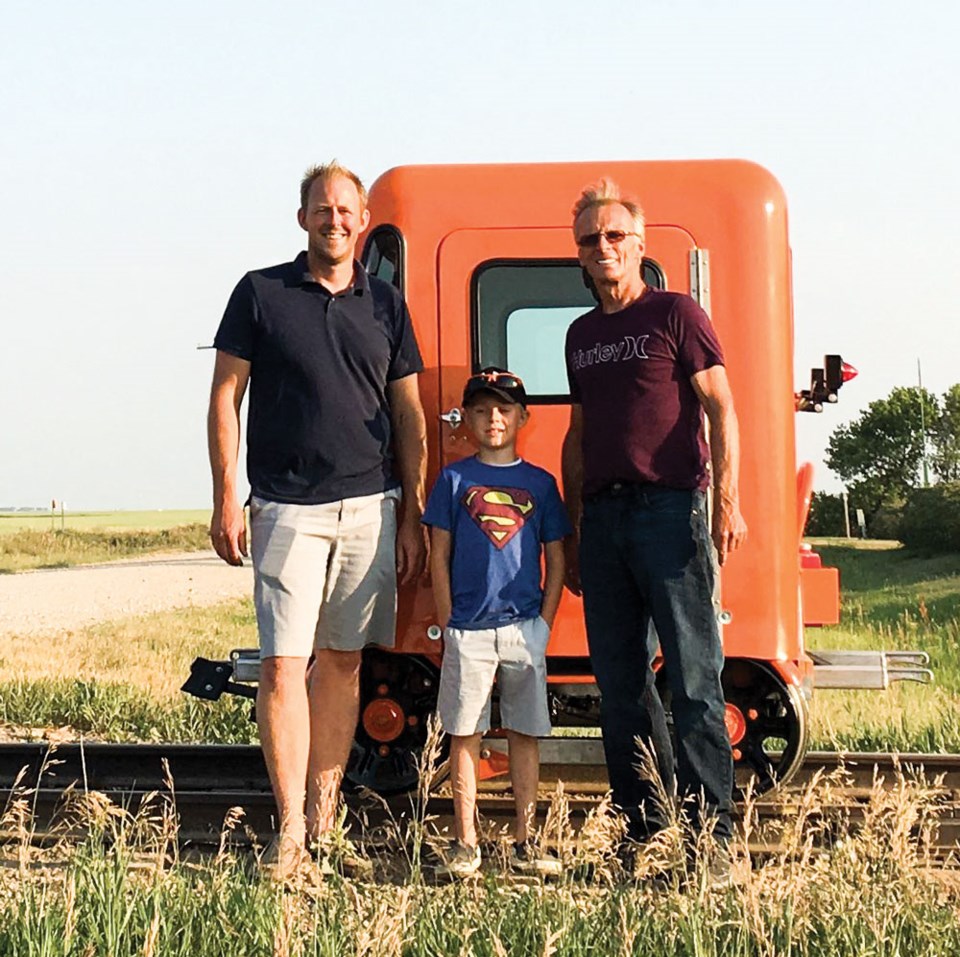Small railcars rolled down the railroad between Estevan and Tribune. Interested onlookers paused to wave and look at the cars, which were at one time fixtures on the railroad, and now are a tribute to railway history.
Members of the Wisconsin-based North Central Railcars Ltd., which is part of the North American Railcar Operators Association, were in southeast Saskatchewan on July 12, as part of their tour of the Canadian Prairies and the northern mid-west U.S.
And they had a special guest in Adriaan Lievaart, the local farmer who has taken an interest in the railcars, commonly known as jiggers.
The jiggers made a round trip on the railroad, which runs from Estevan to Tribune and is operated by Long Creek Rail.
Lievaart, who is the president of Long Creek Rail, is fascinated by the small railcars. He has purchased and restored one that was used by Canadian National Railway. He kept the original engine, and painted it in its original colours.
The maiden voyage happened last week.
“I actually tried it the night before, just to make sure it would work,” said Lievaart.
Once everyone arrived in Tribune, they stopped in at the community hall for a brief lunch, and on the way back to Estevan, they stopped in Torquay for more eats.
“We ran these things down the track and just visited with people from all walks of life,” said Lievaart.
His son Justin and grandson Rylan joined him briefly for the journey, and he said it was enjoyable to have the three generations in the jigger.
“When you ride the rail tracks, you see a certain part of the country you don’t see from the road,” said Lievaart. “People find that really interesting. Maybe because we’re farmers, it’s not as interesting for us. We see that every day. But for a lot of folks, they loved the experience. These guys have been through Alaska, and on every railroad known to man that’s older or abandoned.”
Mike Ford, who is the long-time excursion director for the North Central Railcars Ltd., said the organization has an excursion every year. He added he enjoys railroading and he enjoys operating the motor car.
“We like to put on these trips for people so they can come up and see Canada and the more remote parts, because the more remote it is, the easier it is to travel basically,” said Ford. “You don’t have so much traffic and costings and things like that.”
This year they had 12 to 16 jiggers per day, but only five or six were part of the core group riding each day. Many were like Lievaart, and joined for just one day, or for the journey through a province.
Ford shared Lievaart’s sentiment that he gets to see things he normally wouldn’t see.
“I personally love running in Canada because it’s more remote, and it’s places that most of the people that come along in these trips haven’t seen before,” said Ford. “That particular line (Long Creek) I like it because it’s a nice one-day trip.”
They also try to change up the lines they travel on each year so the participants can see some different sites. They rode the Long Creek Rail a couple of years ago, and Ford was looking forward to making a return journey.
Ford said they often get a lot of interest as they pass through. Older people remember the jiggers from when they were growing up. They also get the attention from middle aged and younger people who want to know when the railcars are, since they haven’t been seen them before.
“We’re a really welcoming bunch, and when we stop, anybody’s welcome to ask questions or take pictures or sit in the cars,” said Ford.
Ford gained his interest in rail motorcars in 1996 when a friend took him on one for a journey. He bought one later that year, fixed it up in the winter, and started running it in 1997.
Lievaart noted the jiggers were used by maintenance workers and other employees who rode the tracks, travelling to locations that needed repairs.
“They carried all of their tools onboard,” said Lievaart. “They used them until the late 1970s or the early 1980s, and that’s when they started putting high-rail equipment on pickup trucks, as you see today.”
People have made a hobby out of restoring them, he said, so people will see all different types and makes.
“The only place they can run them is either on an abandoned track, or a short-line railroad like what we have running from Estevan to Tribune,” said Lievaart.
Lievaart lauded the people on the tour with the North Central Railcars for spending their summer holidays riding the rails on different short-line railroads in the country.
“I couldn’t believe my own eyes when I saw the people,” said Lievaart. “They were from Ohio, Indiana, Iowa and British Columbia. There was a fellow from Saskatchewan. They were just a broad range of individuals who were a part of this.”
The travellers pull their cars from railroad to railroad on the back of trailers, since they can’t use the railroads owned by the bigger companies. Ford said they’re light enough to be on trailers, so some use flatbed trailers, while others have enclosed trailers or they attach the trailer to a camper.
The people who are on this summer’s journey were great to deal with, Lievaart said, and he hopes they will be back again.
Ford said the tour started on July 5 in Duluth, Minn. From there they went to Manitoba, visiting Winnipeg, Carman, Manitou and Morden, and then came to Saskatchewan. Not only have they ridden from Estevan to Tribune in this province, but they rode the Great Western Railway in the southwest corner of Saskatchewan for three days.
Their expedition ended with a visit to the Northern Plains Railroad in North Dakota earlier this week.



